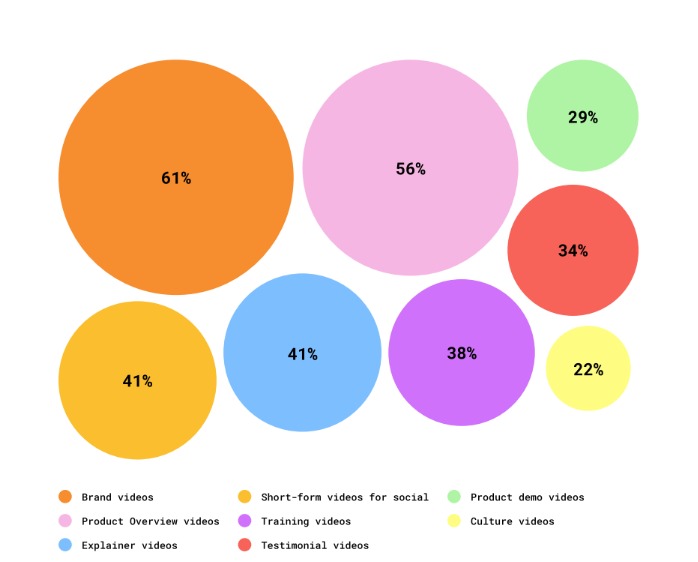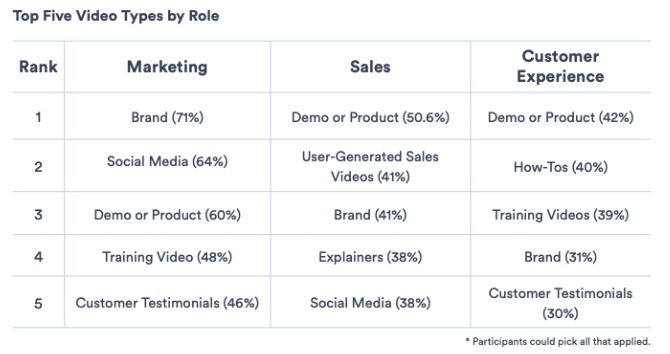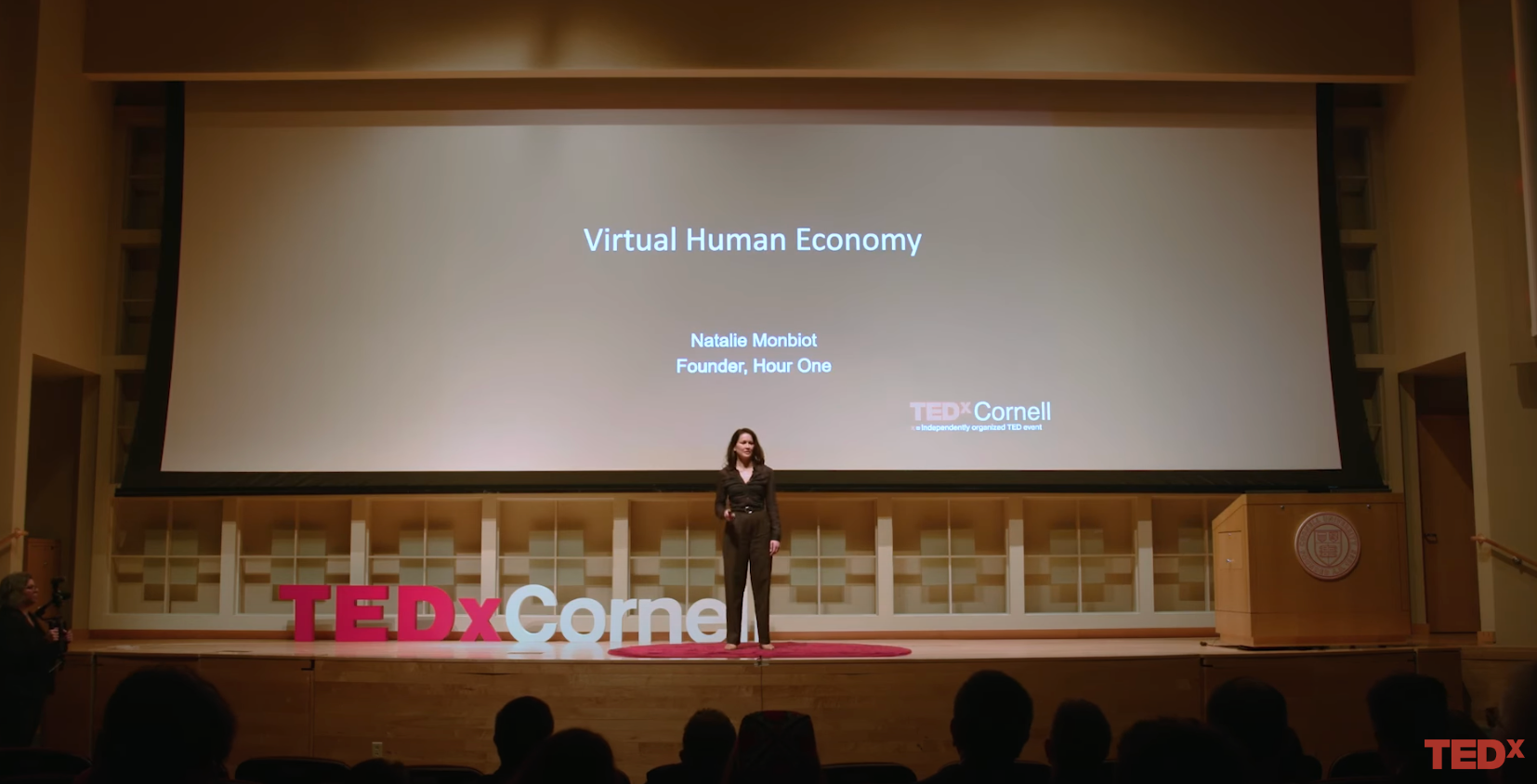A record percentage of 91% of marketers use video as a marketing tool. In 2023, 49% of video marketers said the top video types are brand awareness videos, closely followed by sales videos (48%).
Yes, you read that right, sales videos are in second place among marketing videos. The video trend started back in 2015 and has gained momentum ever since. It’s not surprising because businesses see the results. With sales videos, they see improved ROI and more traffic, leads, and sales.
But the success of video in sales also has a snowball effect on businesses. With consumers getting used to watching videos, the demand for more video content rises, putting pressure on companies to produce more sales videos faster and more efficiently. Here’s where AI can – and will – make a significant difference. And may dominate the entire space in a few years.
Sales video statistics, types, and the importance of a strategy
Sellers feel the positive impact on sales and buyers love video.
According to this report:
- 87% of marketers see a direct, positive impact of video on sales.
- 94% of sales professionals say video aids in building confidence in the potential buyer.
- 91% feel sales videos can help overcome objections during the sales process.
- 89% think their businesses would benefit from more use of video.
Surveys among consumers confirm these assessments.
- 87% of customers say that video helped them make a buying decision.
- 74% of software app buyers say their decision was influenced by video content.
- And probably most significant for sales teams: 66% of the people asked, said they prefer short videos.
Popular types of videos in sales
To reach their marketing and sales goals, brands use a variety of different video types. 61% create brand videos, and 41% create product videos. This goes in line with their declared goals. 49% aim their video strategy primarily at raising brand awareness, and 48% at sales.

Source: https://vidico.com/state-of-video-marketing/
B2B companies focus more on product videos. The preferred types are product demo videos and product presentation videos. Half of these businesses also create training videos and little more than a third use video client testimonials and explainer videos.
Social videos have for a long time been the domain of B2C businesses, but are also gaining popularity in B2B.
There aren’t many things sales and marketing teams agree on, but when it comes to video, they see eye-to-eye, video is a critical component of the entire process.
According to another report, 40% of those producing videos name the lack of strategy to drive video production as a roadblock to reaching their goals. Together with challenges regarding quality, staff and resources, this is the top hurdle to overcome.

The magic of video prospecting
When looking at the customer journey, video is most often used in the early or middle of the voyage. Video prospecting has become a popular practice and many incorporate it into the sales funnel.
Video prospecting works well for several reasons. 86% of marketers believe it makes prospects feel more confident that they’ll receive support after they buy a product Many content consumers prefer video over text. Video content drives 56% higher engagement.
Prospecting that includes a demo video or another type of video also helps close deals 26% faster than prospecting without. If you’re wondering at which phase to add video content to your email prospecting campaign, here’s some valuable data: Cadences that included video at the beginning performed 400% better than others. Out of the total of opportunities created, 83% came from the campaigns in which videos got sent first.
Sales video creation challenges will only keep growing
The demand for video is rising, competition is growing and you need to produce more videos that engage. Inevitably, it’s getting harder for sales teams to reach buyers, even with video. Sales professionals also report that it requires more touch-points to close deals and more stakeholders are involved.
Creating videos is time- and resource-consuming. Especially for sales teams, whose work is primarily with the prospects directly. It also calls for a completely different skill set than drafting and presenting a sales pitch, negotiating a deal and closing it.

Source: https://www.vidyard.com/state-of-video-report/
As a result, videos can lack creativity or the quality required to engage an audience. To reach this level of quality, a videographer is needed, or maybe animators, graphic designers, professional voice-over artists, scriptwriters, actors, and the list goes on.
And if you decide to compromise and produce simpler videos, but more, you enter the dilemma of quality vs quantity. A video producer can shoot live videos, add animations and edit them into professional videos, but each video is still a project on its own. It’s hard to make product presentation videos a routine for every cadence and sales campaign.
To keep up with the competition and reach your prospects effectively, a lot of informative, engaging video content is necessary.
More than 70% of sales leaders who aren’t using video yet, expressed their desire or plan to implement it in the near future. When asked to mark all challenges, 40% sales professional checked these four:
- producing professional quality video that represents the brand well.
- having a strategy to drive video production.
- producing videos that engage.
- Allocating staff time and resources for video production.

Hou you can scale sales video production with AI
The bottom line is, the times when creating videos was a long-term project are long gone. TikTok and Instagram influencers create short videos on their mobile phones in minutes. Companies turn their user manuals into videos and HR conducts interactive video interviews for the initial selection.
And all this with the help of – you guessed it – AI. The name of the game is efficiency. Companies that use AI to create videos save up to 80% on budget and time, compared to traditional video production.
This means, with the same cost and effort you can create 80% more video content using AI.
5 advantages to creating video with AI instead of the traditional way:
- Time – AI video creation tools can take care of many tedious, time-consuming tasks. It starts with deciding on style and building the visual concept. An advanced AI video creator provides templates that work like a modular architecture, including animations. Instead of creating from scratch, you simply rearrange elements. Your video background and outline can be ready in a few minutes.
But that’s not all. AI can generate the written script, turn it into spoken language with or without an avatar. What used to take a team days, now takes hours (or less). - Costs – Traditional video creation is a costly adventure. With AI there’s no need for a crew of expensive professionals. One person can create an entire video from start to finish, including a voiceover and even a commentator. You don’t need to send anyone travelling to a specific location or bring professionals to your office just to make a video.
- Scalability – AI is ideal for businesses that want to grow their video output – which is the majority of companies. You can keep increasing the number of videos produced without having to increase the time and effort.
- Consistency – An AI video generator is reliable and guarantees consistent quality. You don’t have to worry about human errors. In addition, AI makes it easy to stay on-brand with colors and style so you can focus your energies on what matters most.
- Customization – Customizing and personalizing video content becomes an easy task with AI. You can use one video as a template and effortlessly rework it for different purposes. 88% of marketers across the globe say that AI helped them personalize the customer journey.
Just think about your demo videos. If you have several similar products in one product category, you can create product demo videos for each product by duplicating one and just customizing the parts that vary. You can add subtitles in different languages with just one click.
For products in another product category use the same video scheme with a variation. Add as many product presentation videos as you like and let AI do the customization. All you need is to fine-tune in the end.
Into the future of video - not without AI
Does this mean human creativity is being pushed out of video making? Of course not. You can view AI as a resourceful and eager assistant. An AI video creation tool is basically an efficiency tool. The creative human mind still needs to come up with the ideas and the concepts.
Some experts in the video-making market believe that we will see completely new video formats and channels for distribution in the future.
That’s a rather long-term prediction. For the time being, we see that it’s critical to adapt videos to specific audiences’ preferences and curate them to different platforms. This trend is only in its beginning stages as more and more written content is being transformed into video format.
As the volume of video content grows, the struggle to capture the target audiences’ attention is getting tougher. Companies need to continue in their efforts to personalize videos to drive revenue.
According to Gartner, 30% of outbound marketing messages will be AI-generated by 2025. In comparison, in 2022 it was less than 2%. You can imagine what this means for sales-related video content.
One thing that may not immediately jump to mind is that AI-generated content will continue to improve in quality. Avatars will become more relatable and natural and content will become more expressive in general. If you feel AI is not realistic enough yet, make sure to keep your finger on the pulse, it’s only a matter of time.
Creating sales videos with Hour One
Let’s sum up what all this means for sales reps and teams. You’re not a video artist and making videos doesn’t contribute to reaching your monthly sales quota. At least not directly. On the other hand, without video, it takes you longer to close deals and it’s much harder to reach prospects.
You need video, you need it at a respectable quality and you need it personalized, but have no budget for an additional professional.
A tool like HourOne can solve the issue because it’s so unbelievably easy to create a sales video, a demo video or any other type of video you might want to use in your sales process.
Let’s take prospecting via email as an example and how to employ HourOne as a video prospecting tool. Here’s how you create your video with HourOne: You have your pitch that would be sent out by email or in a phone call, right? Use that as your video script or have the tool generate a script off of your pitch.
You can select a template with a presenter and add product images or videos if relevant. You can choose an avatar that fits your brand and a voice that goes well with the message. Or let AI clone your voice and let the avatar speak in your voice.
In the brand hub of HourOne, you add your brand colors, and your logo and create a custom intro and outro that you will use for all your sales videos.
This doesn’t require any specific video skills. You – or anyone else in your team – can create videos and share them across the sales team. Other reps can then use the same video and adapt it for a specific customer, or product. They can replace the avatar and avatar voice in no time.
This is just one example of how to use HourOne’s AI video creation tools to add sales videos to your everyday sales routine. At the same time, you put yourself ahead of the competition and increase profit.








